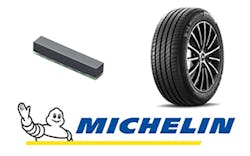RFID Module Improves Tire Performance and Management
What you'll learn:
- What data can the new, tiny embeddable tire RFID module provide?
- The RFID middleware platform that processes and interprets the data.
As radio-frequency identification (RFID) technology continues to evolve, recent advances in cost-effective, low-power wireless electronics and packaging have enabled the RFID tag to become a suitable substitute for barcodes. RFID is a passive electronic chipset that can exchange data with a reader using RF signals.
RFID tire tags can be employed in a variety of applications, including OEM inventory management as well as monitoring the wear and performance of vehicles and vehicle fleets. Through RFID technology, the tires are able to "communicate" by linking them to a more global ecosystem
Typically, transponders are placed on the inside surfaces of tires. The transponders can be affected by the absorption of electromagnetic waves, or interference at the location of installation. Further, since the tire deforms a great deal during operation, there’s the potential problem of the transponder breaking.
RFID Advances
However, a look around the industry shows that these issues are being solved. For example, Murata Manufacturing has co-developed a new generation of RFID modules with Compagnie Générale des Établissements Michelin (better known simply as Michelin, one of the world’s largest tire companies) that are embedded into tires. The passive RFID tags require no external power supply and will continue to operate while being driven over extremely high mileages. This technology delivers low cost and easy tire traceability throughout its lifespan, enabling the management of inventory logistics, aftermarket maintenance, and recycling operations.
“RFID technology is a key enabler to gain efficiency and optimize tire operations, but also to improve the customer experience while identifying tires and associating data. An embedded tag is the only way to identify tires, from the cradle to the grave, consistently,” said Jerôme Barrand, Michelin RFID program leader.
This new generation of RFID tags is already in more than four million Michelin tires. Currently, Michelin uses the RFID tags in commercial vehicles such as trucks, as well as in buses and passenger cars. Michelin is working toward expanding this rollout to 100% of its tires starting in 2024.
Since the technology will be available, from now on, to any other tire manufacturer, the company anticipates key players in the market will embrace RFID for improved tire traceability.
Murata’s Mini Module
Murata brings to the project experience and knowledge of RFID technology and the ability to downsize its solutions. Improving the reliability compared to existing RFID tags while minimizing cost were said to be critical factors when developing the tire embeddable RFID tag. Designed and manufactured by Murata, the RFID module is approximately the size of a grain of rice, measuring 1 × 1 × 6 mm.
Similarly, a suitable antenna for these tags must have low cost, a low profile, and, especially, a small size. Here, the bandwidth requirement is less critical. By inserting it into a simple spring antenna designed and manufactured by HANA Technologies, the RFID tag in the Murata-Michelin system achieves a simple communication architecture, enabling it to link to the tire ecosystem.
In addition to supplying the RFID module, Murata is offering its id-Bridge platform (RFID middleware), which processes and interprets the data transmitted from the tire embeddable RFID tag in conformance with ISO standards. ISO, the International Organization for Standardization, specifies the general requirements and data structure for coding the tire embeddable RFID tag. ISO20912 specifies the test methods for validating the conformance of RFID-enabled tires.
This middleware processes and interprets the data transmitted from tagged goods. Murata’s id-Bridge Middleware and Dashboard suite 4.0 (formerly RSA System administrator) is a web-based tool that manages and controls RFID hardware and turns rough RFID data into valuable information.
Among other benefits, using RFID enables improved tire management as well as opening up possibilities for offering predictive-maintenance services to improve the driver experience.
Since RFID technology ensures exact tire identification, it’s conceivable that it will enable functions such as advanced driver-assistance systems (ADAS) to adapt to specific tire characteristics, and drivers could see a tire status display on their dashboard.

